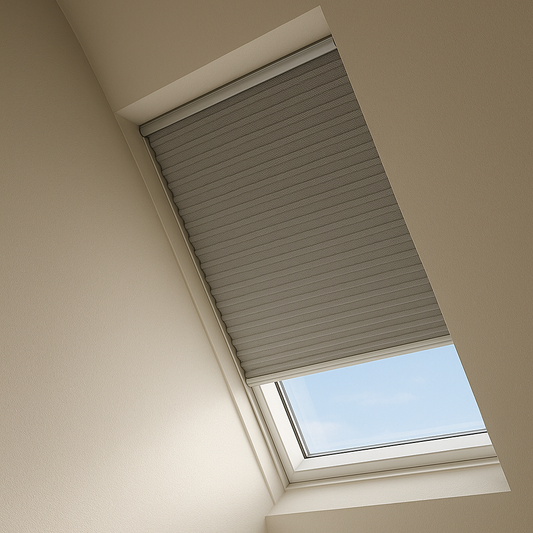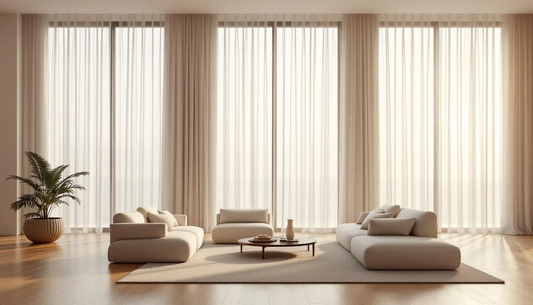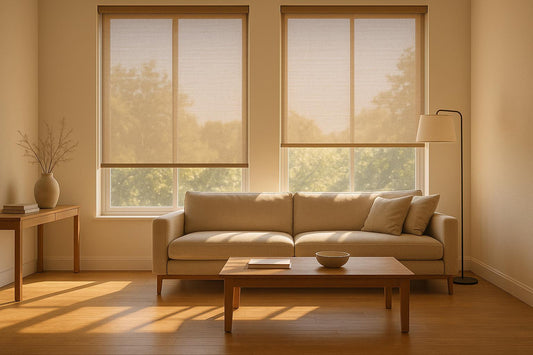
How to Measure Windows for Custom Shades
Accurate window measurements are crucial for custom shades to fit properly and function well. Even minor errors can cause gaps, poor light control, or awkward fits. Here's how to measure windows step-by-step:
- Tools Needed: Steel measuring tape, pencil, notepad, stepladder, and level.
- Preparation: Measure each window individually, record dimensions in Width x Height (W x H) format, and round to the nearest 1/8 inch.
- Inside Mount: Measure width (top, middle, bottom) and height (left, center, right), using the smallest values. Ensure at least 2 inches of frame depth.
- Outside Mount: Add 2–3 inches to the width and height for better coverage. Account for obstructions and decide where the shades will extend.
For specialty windows like bay or arched designs, measure each part separately or create templates for irregular shapes. Avoid common mistakes like using improper tools, rounding incorrectly, or assuming all windows are identical. Double-check measurements for accuracy and label each window clearly.
Whether you prefer sleek inside mounts or light-blocking outside mounts, precise measurements ensure shades perform as expected and look great.
Tools and Preparation
Tools You'll Need
When it comes to measuring windows for custom shades, having the right tools is essential. Start with a steel measuring tape - one that measures in inches and extends at least 25 feet. Steel tapes are ideal because they stay rigid when extended, providing more accurate readings compared to fabric or plastic options.
You'll also need a pencil and notepad to jot down measurements immediately, avoiding any chance of forgetting or mixing them up.
For taller windows, a sturdy stepladder is a must. Choose one that's tall enough to let you reach safely without overextending yourself. Always reposition the ladder instead of stretching too far to maintain stability.
A level can also come in handy to check if the window frame is square, especially if the frame shows signs of settling over time.
Once you’ve gathered your tools, it’s time to prep your workspace for accurate measuring.
Preparation Tips
Even if windows look identical, measure each one individually. Tiny differences - often fractions of an inch - can occur due to construction inconsistencies or natural settling, and these variations are critical for custom shades.
Always record your measurements in the Width x Height (W x H) format. This standard ensures clarity when placing your order and prevents any confusion. Clearly label each measurement with "W" or "H" to avoid mix-ups.
Round your measurements to the nearest 1/8 inch. This level of precision ensures a snug fit while keeping the process practical. Most steel measuring tapes include clear 1/8-inch markings, making this step straightforward.
For the most accurate results, measure the width at three points: the top, middle, and bottom. Do the same for the height, measuring the left, center, and right. Use the smallest measurement for each dimension - this accounts for any irregularities in the window frame and ensures a proper fit.
Before you begin, make sure the area is clear for safe ladder placement and easy movement. Good lighting is also key. If natural daylight isn’t sufficient, use a bright flashlight to read the tape measure clearly.
Finally, label each set of measurements with the specific window location, such as "Living Room - Left Window" or "Master Bedroom - Center Window." This simple step is especially helpful when working with multiple windows, saving you from confusion and ensuring each shade fits its intended spot perfectly.
How to Measure Windows for your Blinds and Shades | SelectBlinds.com
Mount Types: Inside vs. Outside Mount
Choosing between an inside or outside mount is more than just a style decision - it impacts how your shades function, look, and fit your window. Each option has its own perks depending on your window design, personal preferences, and how much light control you need.
What is an Inside Mount?
With an inside mount, your shades are installed inside the window frame, sitting neatly within the opening. The hardware is attached directly to the frame or the header board inside the recess.
For an inside mount to work, your window frame needs at least 2 inches of depth. Without enough depth, the shades might not sit properly or could interfere with the window's operation.
This mounting style gives your windows a sleek, tailored appearance, emphasizing any decorative trim. It’s a great option if you want your window frames to stand out.
However, there is a downside: inside mounts don’t block light as effectively. Light can seep through the edges where the shade doesn’t fully meet the frame. Plus, the shades need to be slightly smaller than the window opening, leaving a bit of the glass exposed.
If your window lacks the required depth or you’re aiming for better light control, you might want to explore an outside mount instead.
What is an Outside Mount?
An outside mount goes beyond the window frame, covering both the window and the surrounding trim. The hardware is mounted to the wall or trim outside the frame.
This style offers superior light control because the shades extend beyond the frame, covering gaps that might let light in with an inside mount. You can even extend the coverage several inches on all sides, virtually eliminating light leakage.
Outside mounts are ideal for windows that don’t have enough depth, frames that aren’t perfectly square, or windows with obstructions like cranks or handles. They can also make smaller windows look larger by extending the shades beyond the actual frame.
The main drawback? Outside mounts cover your window trim, which might not be ideal if you have decorative molding or frames you want to showcase. Additionally, they require extra wall space for proper installation.
Comparison Table: Inside vs. Outside Mount
Here’s a quick breakdown of the key differences between these two mounting styles:
| Feature | Inside Mount | Outside Mount |
|---|---|---|
| Appearance | Sleek, minimalist look that highlights window trim | Bold look that can make windows appear larger |
| Light Control | Moderate – light can seep through edges | Excellent – overlaps frame to block light leaks |
| Privacy | Decent during the day; less effective at night due to gaps | Excellent – full coverage with minimal gaps |
| Installation | Requires at least 2 inches of frame depth and a square frame | Works with any window, mounts to wall or trim |
| Window Trim | Showcases decorative molding and frames | Covers trim completely |
| Measurement Precision | Precise fit needed for the frame opening | More flexible – can adjust coverage area |
| Best For | Highlighting frames, modern decor, unobstructed windows | Maximum privacy, irregular frames, light-sensitive spaces |
Both mounting styles have their strengths, so the right choice depends on your priorities - whether it’s showcasing your window’s trim or achieving maximum light control and privacy.
Step-by-Step Instructions for Measuring Windows
Now that you’re familiar with the differences between inside and outside mounts, it’s time to measure your windows accurately. Follow these steps to ensure you get the right fit for your chosen mount type.
How to Measure for an Inside Mount
Inside mounts require precise measurements since the shades need to fit snugly within the window frame. Here’s how to measure correctly:
Width:
Measure the width of the window opening at three points - top, middle, and bottom - because frames can sometimes vary slightly. Write down the smallest measurement. This ensures the shades fit through the narrowest part without any issues.
Height:
Measure the height of the window opening at three spots - left, center, and right. Again, use the smallest measurement to avoid the shades being too long and bumping into the sill or other obstacles.
Depth:
Check the depth of the window frame by measuring from the front edge to the glass or any obstructions. Most shades require at least 2 inches of depth to fit properly. If your frame is shallower than that, an outside mount might be a better option.
Recording Measurements:
Write down your measurements as width × height, using the smallest values. For example: 34.25" × 48.5".
How to Measure for an Outside Mount
Outside mounts don’t have to fit within the window frame, giving you more flexibility. Here’s how to measure for them:
Coverage Area:
Start by measuring the width of the window opening, then add 2–3 inches to each side. This extra width helps block out light completely. For example, if the window is 36 inches wide, your shade should be 40–42 inches wide. For height, decide where you want the shade to start and end, typically adding 2–4 inches at both the top and bottom.
Clearing Obstructions:
Make sure the area around the window is free of any obstructions. Consider the placement of the window sill and decide if the shades should rest on it or extend below it.
Final Dimensions:
Record your desired finished size as width × height. Unlike inside mounts, these measurements will be the exact dimensions for your shades.
Special Cases: Bay and Specialty-Shaped Windows
If you’re working with bay, arched, or irregularly shaped windows, you’ll need to adjust your approach. Here’s how to tackle these unique cases:
Bay Windows:
Treat each section of the bay window as a separate window. Measure the width and height of each panel individually and note any angles between them. In most cases, using separate shades for each section works better than one shade covering the entire bay.
Arched Windows:
For arched windows, measure the width and the straight sides first. Then, measure the height from the base to the top of the arch. Many homeowners prefer shades that cover just the rectangular portion, leaving the arch exposed for decoration.
Templates for Complex Shapes:
For irregularly shaped windows, making a template can be helpful. Use cardboard or kraft paper to trace the exact outline of the window. Tape the paper over the opening, trace the edges, and send the template along with your measurements to ensure a precise fit.
Skylights and Angled Windows:
Measure the width and height as you would for a standard window, but also note the angle of the installation relative to the floor. This detail helps in selecting the right hardware and ensures the shade fits properly.
For specialty windows, taking photos from multiple angles can be a great way to double-check your measurements. These references can help confirm that your dimensions match the actual window shape, reducing the chances of errors.
sbb-itb-f0eb538
Common Measurement Mistakes and How to Avoid Them
Accurate measurements are the backbone of a perfect custom shade fit. Mistakes can lead to reordering, delays, and frustration. Here’s a look at common pitfalls and practical tips to help you get it right the first time.
Common Errors to Watch For
Measuring windows for custom shades might seem straightforward, but small missteps can cause big headaches. One of the most frequent mistakes is assuming all windows are the same size. Even in new homes, windows that look identical can have slight variations that impact how your shades fit.
Another common issue is using the wrong tools. Cloth measuring tapes, rulers, or yardsticks can stretch, sag, or simply lack precision. A steel tape measure is your best bet for getting accurate readings.
Mixing up width and height is another easy-to-make error, especially when measuring multiple windows in one go. Without a clear system for recording dimensions, it’s all too easy to confuse these numbers.
Rounding measurements incorrectly can also cause trouble. Some people round to the nearest half-inch or inch, thinking it won’t matter. However, custom shades require precision - down to the nearest 1/8 inch - for a proper fit.
Tips for Double-Checking Accuracy
To ensure your measurements are spot-on, measure each dimension at three points - top, middle, and bottom for width; left, middle, and right for height. Always use the smallest value for inside mounts to ensure the shades fit snugly.
Keep your notes organized. Assign a unique identifier to each window and record measurements in the format "Width x Height" (W x H). Double-check your numbers, especially if there’s more than a 1/8-inch variation between measurements. Before placing your order, review the manufacturer’s guidelines to ensure your dimensions meet their specifications.
Error-Solution Table
| Common Measurement Error | Solution / How to Avoid |
|---|---|
| Assuming all windows are the same size | Measure every window individually, even if they look identical, and label each one with a unique ID |
| Using a flexible or incorrect measuring tool | Stick to a steel tape measure for consistent and accurate results |
| Not measuring at multiple points | Measure width at the top, middle, and bottom; height at the left, middle, and right. Use the smallest width and tallest height for inside mounts |
| Mixing up width and height | Always record dimensions as "Width x Height" (W x H) to avoid confusion |
| Incorrect rounding | Round to the nearest 1/8 inch. For inside mounts, rounding down can help ensure a proper fit |
| Overlooking obstacles | Check for handles, cranks, locks, or trim that might interfere with shade operation |
| Single measurement per dimension | Take multiple measurements and rely on the smallest value for inside mounts |
Preparing to Order Custom Shades from World Wide Shades

Now that you’ve got your precise measurements ready, it’s time to prepare for ordering. Staying organized and familiarizing yourself with the available options will make the process seamless and ensure your custom shades turn out just right.
Organizing and Submitting Measurements
Start by recording each window’s measurements in inches, down to 1/8". Use the standard format of width by height (W x H) and assign a unique label to each window, like “Living Room Window 1”. Don’t forget to include the mount type - this detail is crucial for achieving the right fit.
For instance, if a window measures 36 inches wide and 48 inches tall, note it as 36" W x 48" H. If the width is 35 7/8 inches, record it exactly like that - don’t round it up to 36 inches. Precision is key.
To keep things clear, create a simple chart or list that includes:
- Window location
- Mount type (inside or outside)
- Exact dimensions
Double-check that your measurements align with the guidelines you followed earlier. Once everything is organized, you’re ready to explore the custom shade options at World Wide Shades.
Product Options
World Wide Shades offers a wide range of custom window treatments to match different styles and needs:
- Roller Shades: Sleek and modern with light-filtering or blackout options
- Solar Shades: Minimize glare while keeping your view intact
- Blackout Shades: Block almost all light - perfect for bedrooms or media rooms
- Light-Filtering Shades: Let in soft natural light while maintaining privacy
- Motorized Shades: Convenient, battery-powered shades controlled by a remote
If you have uniquely shaped windows - triangular, arched, or angled - specialty-shaped shades are available to fit those configurations. Plus, with over 1,200 material options, you’ll find fabrics and colors to complement any décor.
Thanks to your precise measurements, every custom option will fit like a glove, whether you go for a sleek roller shade or a high-tech motorized one.
Conclusion: Achieving a Perfect Fit with World Wide Shades
Getting the perfect fit for your shades comes down to precision and careful preparation. From the steps outlined earlier, here are the essentials to keep in mind: decide whether you want an inside or outside mount, use a steel measuring tape for precise measurements down to the nearest 1/8 inch, and take multiple measurements since windows are rarely perfectly square. For inside mounts, always go with the narrowest width measurement to ensure a snug fit. Be consistent when recording dimensions, as even windows that look identical can differ by tiny fractions of an inch.
Steer clear of the common mistakes mentioned earlier - using the wrong tools, making size assumptions, or rounding measurements improperly can throw off your results. If your window isn’t square or lacks the necessary depth, an outside mount can often be the better choice for both fit and functionality.
Once you’ve nailed down your exact dimensions, you’re ready to place your order. World Wide Shades makes it easy to customize your shades to your specifications. Whether you’re after roller shades, blackout styles, or the convenience of motorized options, every detail is tailored to bring both style and practicality to your space.
FAQs
What are the advantages of choosing an inside mount for custom shades instead of an outside mount?
Inside mount shades fit neatly within the window frame, offering a clean and streamlined look. This style works well if you want to highlight decorative window trim or prefer a simple, understated design. Plus, they save wall space and fit snugly, making them especially useful for smaller rooms or windows with deep frames.
That said, accurate measurements are key for inside mounts to fit properly. Be sure to follow the measuring guide closely to get it just right.
How do I measure uniquely shaped windows, like arched or bay windows, for custom shades?
Measuring windows with unconventional shapes, like arched or bay windows, calls for careful attention to detail to get it right. For arched windows, measure the width at its widest point and the height from the base to the top of the arch. When dealing with bay windows, take measurements for each individual panel, noting both the width and height for every section.
A steel measuring tape is your best bet for accuracy, and it’s always a good idea to double-check your numbers before placing an order. If you're feeling uncertain, reaching out to a professional or contacting customer support can help ensure your custom shades fit perfectly.
What can I do if my window frame isn’t deep enough for an inside mount?
If your window frame lacks the depth needed for an inside mount, an outside mount is a great alternative. These mounts attach directly to the wall or molding around the window, offering both a practical and stylish solution without depending on the frame's depth.
To get the best fit, carefully measure the width and height of the area you want the shades to cover. Accurate measurements ensure the shades provide the coverage and appearance you’re going for. If you're uncertain about the process, reaching out to a professional can help ensure everything looks and functions just right.



